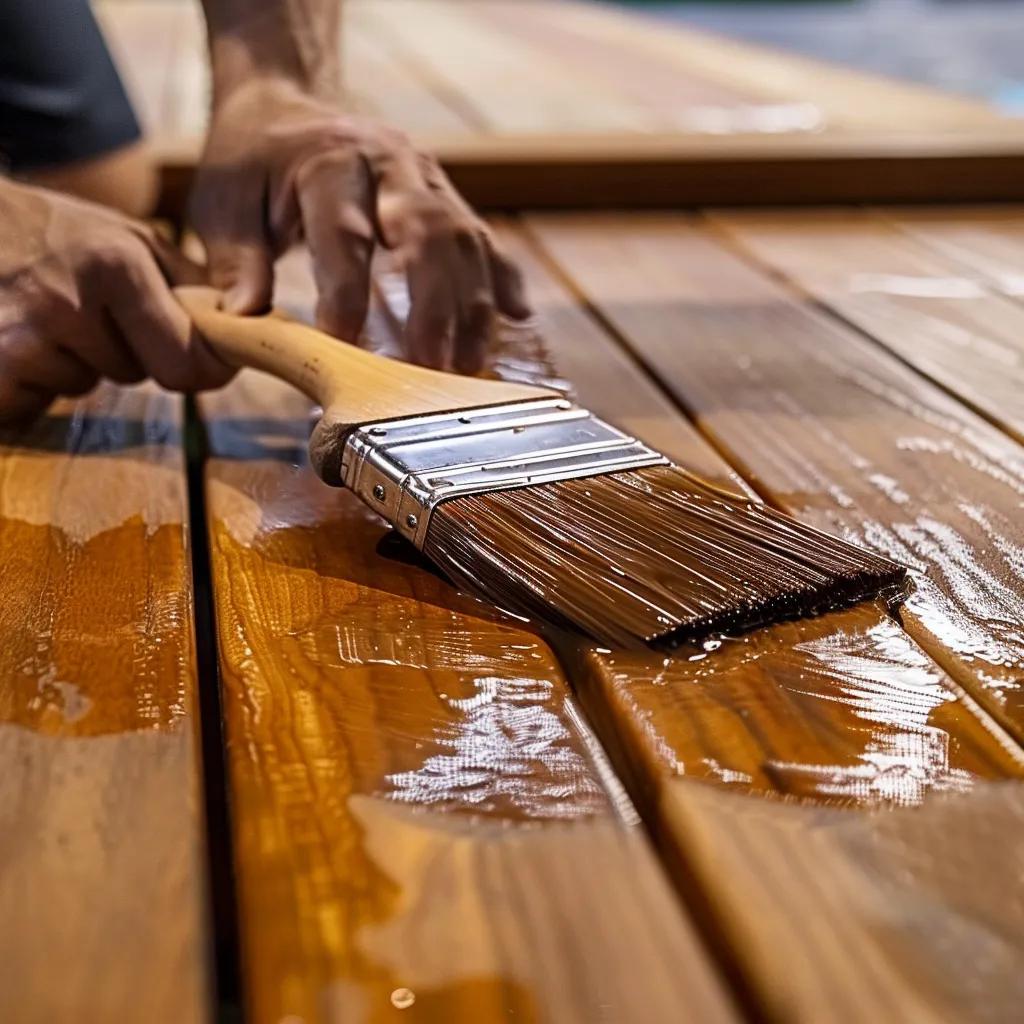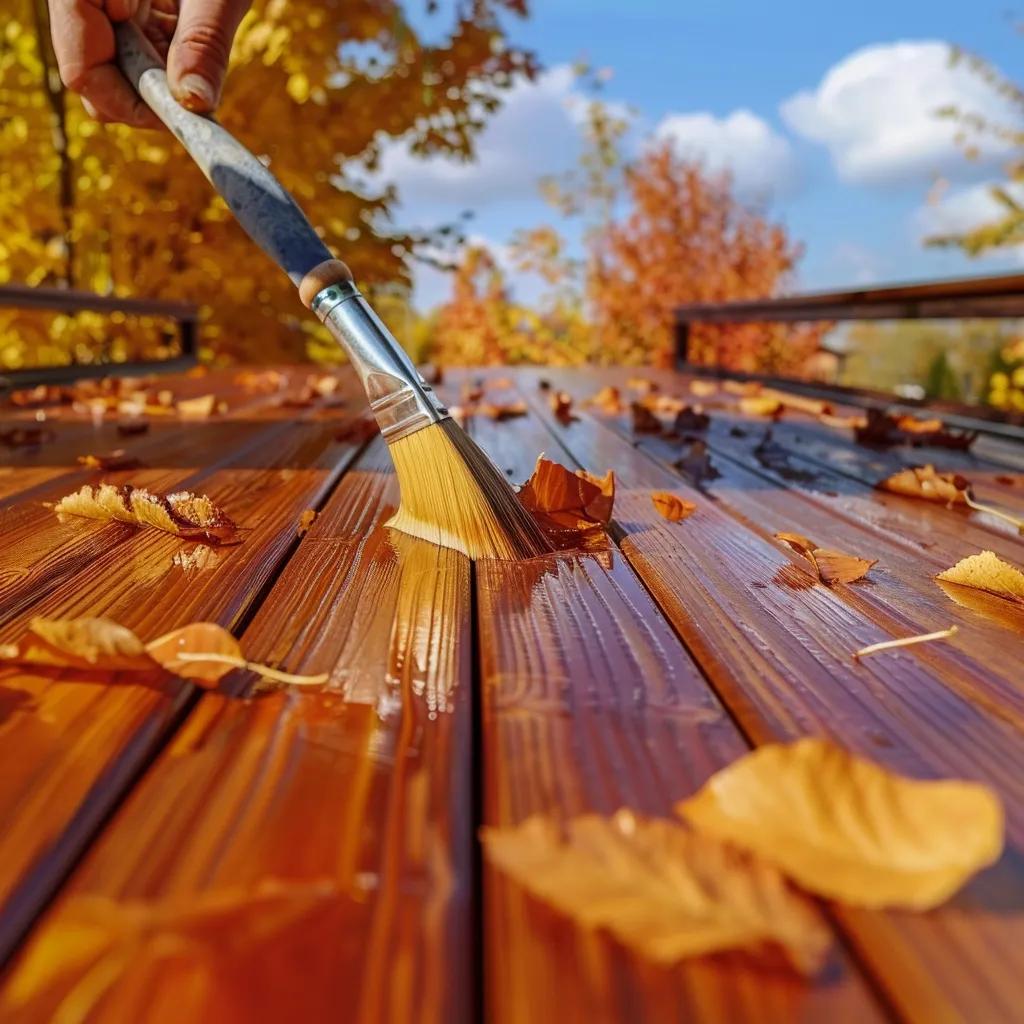Fall Season Deck Stain Guide: How to Prepare and Protect Your Deck Before Winter
As autumn arrives, it presents the ideal opportunity to fortify your deck against winter’s harsh embrace. Applying a premium deck stain that deeply penetrates wood fibers, seals every pore, and effectively blocks moisture intrusion is key to preserving its beauty and integrity.
The Science of Wood Penetration
Wood stains are engineered to soak into the wood’s surface, a critical step in defending against moisture and UV damage. The extent of this penetration is dictated by the stain’s composition, with oil-based formulations typically reaching deeper than their water-based counterparts. This profound penetration acts to seal the wood, preventing water absorption and significantly extending your deck’s lifespan.
This research underscores the article’s emphasis on the vital role of stain penetration for robust deck protection.
In this guide, you’ll uncover why autumn is the prime season for staining, learn how to thoroughly clean and mend your deck, gather insights on selecting the finest stain and sealer, follow step-by-step application techniques, discover essential winter maintenance strategies, and get material-specific care tips for both wood and composite surfaces. Furthermore, this guide highlights how professional deck winterization services can seamlessly integrate stain application into comprehensive cleaning and repair packages, ensuring extended deck life, enhanced visual appeal, and year-round safety.
Why Is Fall the Best Time to Stain Your Deck Before Winter?
Staining your deck in the fall offers the perfect blend of moderate temperatures and low humidity, allowing the stain to deeply penetrate the wood, cure properly, and establish a resilient barrier that effectively repels moisture and withstands freeze-thaw damage, providing crucial winter protection. This strategic timing ensures optimal stain adhesion, minimizes your winter maintenance workload, and preserves your deck’s aesthetic appeal throughout the colder months.
What Makes Fall Ideal for Deck Staining?
Autumn provides consistent daytime temperatures ranging from 50°F to 85°F and humidity levels below 60%, creating the perfect environment for stain solvents to evaporate and meld with wood fibers. These temperate conditions accelerate the cross-linking of resins and binders, which in turn boosts water repellency and adhesion. With stable autumn weather, stain penetration is maximized, setting the stage for enduring moisture protection and preventing damage from winter elements.
How Does Fall Staining Extend Deck Lifespan?
By sealing wood pores in the fall, you effectively block moisture from penetrating before freezing occurs, thereby preventing rot, inhibiting mildew growth, and stopping wood splitting that can result from ice expansion.
- Deep penetration fills wood capillaries, significantly reducing water absorption.
- The protective surface film actively resists ultraviolet degradation, preserving wood fibers.
- Built-in mildew-resistant additives actively inhibit fungal development on damp surfaces.
Establishing a hydrophobic barrier before winter arrives minimizes stress from freeze-thaw cycles and lays the groundwork for a vibrant appearance come springtime.
Is It Ever Too Late to Stain Your Deck in Fall?
It can indeed be too late if overnight lows consistently dip below 45°F, as cooler temperatures can impede the stain’s curing process and potentially trap solvents within the wood. Planning your stain application before early November is crucial to ensure a complete cure before the onset of freezing nights. Should temperatures plummet too rapidly, consider applying a fast-drying water-based sealer as a temporary shield while scheduling a full staining session for the following season.
How Do You Properly Prepare Your Deck for Fall Staining?
Thorough fall preparation involves meticulously removing debris, treating any mildew, conducting a comprehensive structural inspection, and making necessary repairs. These steps are essential to ensure the deck stain adheres uniformly and forms a seamless protective coating, safeguarding against moisture entrapment and promoting long-lasting results.
What Are the Essential Deck Cleaning Steps Before Staining?

Begin by sweeping away all leaves, dirt, and dust to expose the underlying wood surface and prevent organic matter from decaying beneath. Treat any mold or mildew with an oxygen-bleach deck cleaner to restore the wood’s porosity, then use a pressure washer set between 500–800 psi to rinse away residue without harming the wood fibers. Once the deck is completely dry, the clean surface will allow the stain binders to fully bond and penetrate effectively.
How to Inspect and Repair Deck Damage Before Winter?
Carefully inspect each board for any cracks, splits, or signs of rot that could compromise the deck’s structural integrity and lead to uneven stain application. Check all fasteners to ensure they are secure and free from corrosion, tightening or replacing them as needed. Replace any boards that show decay or significant warping with weather-resistant lumber to guarantee that the stain adheres evenly across sound wood surfaces and to prevent water infiltration at vulnerable points.
Which Tools and Cleaning Agents Are Best for Fall Deck Preparation?
Below is a summary of recommended tools and agents for a deep clean and thorough preparation of your deck surface before staining.
Utilizing the correct combination of tools and cleaning agents is paramount to achieving a pristine surface that is perfectly prepared for optimal stain penetration and adhesion.
How to Choose the Right Deck Stain and Sealer for Winter Protection?
Selecting the ideal deck stain and sealer involves carefully balancing penetration depth, UV resistance, and moisture repellency to create a robust protective layer that effectively shields your deck from winter’s hazards.
Impact of Weather on Decking Materials
Your choice of stain and sealer should always take into account the specific local climate. For regions experiencing harsh winters, it’s particularly beneficial to opt for stains that offer superior moisture resistance and robust UV protection. This article emphasizes the critical importance of selecting the right product based on prevailing environmental conditions to ensure your deck’s longevity and maintain its attractive appearance.
This research strongly supports the article’s guidance on selecting appropriate stains and sealers tailored to regional weather patterns.
What Are the Differences Between Oil-Based and Water-Based Deck Stains?
Oil-based stains are known for their deep penetration and slower curing process, allowing the binders to effectively bond within the wood pores, while water-based formulas typically dry faster and often incorporate advanced UV blockers for enhanced surface protection.
The decision between oil- and water-based options ultimately depends on whether your priority is deep moisture resistance or superior UV defense.
How Do Solid, Semi-Transparent, and Clear Stains Compare for Winter Use?
The level of opacity in a stain significantly influences both its durability and its visual impact. Solid stains provide the maximum coverage and longest lifespan, whereas clear finishes highlight the natural wood grain but necessitate more frequent recoating.
Solid stains are the ideal choice for the most demanding winter climates, while clear options are best suited for milder regions and projects where the natural wood aesthetic is paramount.
Which Deck Stain Brands Offer the Best Winter Protection?
Leading manufacturers consistently develop winter-specific stains that feature a blend of deep-penetrating resins, protective biocides, and effective UV filters to deliver reliable protection throughout the challenging freeze-thaw cycles of winter.
- Behr Premium Solid Color Waterproofing Stain & Sealer: Widely recognized for its exceptional adhesion and superior moisture repellency.
- Cabot Semi-Transparent Deck and Siding Stain: Expertly balances the enhancement of natural grain with effective mildew resistance.
- Sherwin-Williams SuperDeck Exterior Deck Stain: Provides advanced UV absorbers and potent mildew inhibitors for lasting protection.
- Defy Extreme Semi-Transparent Wood Stain: Incorporates zinc nano-technology to actively prevent algae growth and color fading.
How to Select Stain Color and Finish for Fall Application?
Your color choice plays a role in heat absorption, fade resistance, and overall visual harmony with your home’s architecture. Consider opting for medium-tone hues that absorb a moderate amount of warmth, which can help expedite the curing process without overheating the wood. Darker finishes, conversely, can boost the stain’s longevity by effectively blocking UV rays. A semi-gloss finish adds a subtle reflective sheen that helps water shed and beautifully highlights the natural wood grain.
What Is the Best Way to Apply Deck Stain in Fall for Optimal Winter Protection?
Applying deck stain in the fall, under the recommended environmental conditions and by meticulously following precise application steps, ensures the creation of a fully cured, resilient coating that effectively shields the wood from moisture, UV rays, and the damaging effects of freeze-thaw cycles.
What Are the Ideal Weather Conditions for Fall Deck Staining?
Select a period of at least 48 hours with daytime temperatures consistently between 50°F and 85°F, and ensure humidity levels remain below 60%. Crucially, check the forecast to confirm no rain is expected, allowing ample time for the surface to dry and solvents to evaporate for a complete cure.
What Is the Step-by-Step Process for Applying Deck Stain in Fall?

- Ensure Surface Dryness – Confirm that the deck boards are completely dry, ideally after a full 24 hours without any rainfall.
- Sand Imperfections – Lightly sand any rough patches or areas with peeling finish to promote better stain adhesion.
- Stir and Pour – Thoroughly mix the stain to ensure uniform pigment distribution, then pour it into a paint tray.
- Apply First Coat – Using a brush or roller, apply a smooth, even coat, always working in the direction of the wood grain.
- Back-Brush Excess – Immediately use a brush to back-brush any excess stain, working it into the wood pores and eliminating any puddles.
- Wait Recommended Dry Time – Allow the first coat to dry completely according to the manufacturer’s instructions before applying a second coat.
- Apply Second Coat (if needed) – Apply a second layer for richer color depth and enhanced protective qualities.
Adhering to these steps guarantees the formation of a seamless protective film and maximizes stain adhesion.
How Long Does Deck Stain Take to Dry and Cure Before Winter?
- Oil-Based: Requires 24–48 hours to dry, with a full cure taking 7 days.
- Water-Based: Dries in 2–4 hours, with a complete cure in 3 days.
- Hybrid: Dries in 12–24 hours, with a cure time of 5 days.
Ensuring the stain is fully cured before freezing temperatures arrive is essential for locking in moisture resistance and preventing any tackiness that could attract and trap debris.
How Can You Maintain and Protect Your Deck Throughout Winter?
Consistent winter care is vital for preserving the stain barrier, preventing surface damage, and preparing your deck for spring maintenance by minimizing moisture accumulation and reducing stress from freeze-thaw cycles.
What Are Safe Snow and Ice Removal Methods for Decks?
Utilize plastic-bladed shovels or stiff brooms to clear snow without scratching the stained surfaces. It’s important to avoid using rock salt and metal shovels. If ice melting is necessary, apply calcium chloride pellets sparingly to melt ice without causing chemical harm to the sealer.
How to Prevent Moisture Traps from Furniture and Planters?
Elevate your outdoor furniture and potted plants by placing them on plastic or rubber risers. This simple step allows for essential airflow and drainage beneath heavy items. Storing cushions and planters in a dry, sheltered location will further reduce trapped moisture and help preserve the stain’s integrity.
When Should You Reapply Deck Stain or Sealer After Winter?
Conduct a thorough inspection of your deck in early spring, once the wood has dried and temperatures consistently remain above 50°F. Address any worn or faded areas immediately with touch-ups. Plan for a complete recoating every 1–2 years for clear stains or every 3–5 years for semi-transparent finishes to maintain continuous, effective protection.
What Are the Differences Between Wood and Composite Deck Care Before Winter?
Wood decks necessitate the application of stain and sealer to effectively block moisture and prevent rot, whereas composite and PVC decks primarily require cleaning and careful ice management, as staining is not a necessary step.
How Should You Winterize Wooden Decks Differently?
Wooden decks require sanding any areas with peeling finish, followed by the application of a penetrating stain and a water-based sealer to fill pores and block moisture. It’s also crucial to replace any decayed boards and tighten loose fasteners to eliminate gaps where water might collect before freezing.
What Are the Winter Care Tips for Composite and PVC Decks?
Composite and PVC decks are resistant to staining but do require the removal of debris and a gentle washing with mild detergent to prevent mold growth. Use plastic shovels for snow removal and steer clear of harsh chemicals that could potentially degrade the composite cap layers. Afterward, rinse the deck thoroughly and allow it to air dry completely.
What Common Winter Deck Problems Can Fall Staining Prevent?
A properly executed fall stain application creates a vital barrier that effectively combats the primary causes of winter deck damage—moisture, freeze-thaw cycles, and UV exposure—by thoroughly sealing and shielding the wood surfaces.
How Does Staining Protect Against Mold, Mildew, and Rot?
Stain forms a water-repellent barrier and frequently includes biocides that actively inhibit fungal spores, thereby preventing moisture buildup and subsequent wood decay. By sealing any existing cracks and capillaries, the stain effectively stops organisms from colonizing damp wood fibers and causing rot.
How Does Deck Stain Help Prevent Freeze-Thaw Cycle Damage?
Penetrating stain fills microscopic pores within the wood, significantly limiting water absorption. This means less ice formation occurs within the wood cells. This inherent elasticity helps reduce the expansion stress and cracking that can result from repeated freeze-thaw cycles.
How Does Proper Staining Reduce UV Damage and Fading?
The UV-resistant pigments present in deck stains are designed to absorb and reflect damaging solar rays, offering crucial protection to lignin and cellulose fibers from photodegradation. Furthermore, a sealed surface film prevents surface chalking and color loss that can occur due to prolonged sun exposure.
Applying stain in the fall not only effectively locks out moisture and resists the wear and tear of winter but also ensures your deck emerges in the spring ready for year-round enjoyment with minimal upkeep. Consider collaborating with professional deck winterization experts to combine expert cleaning, repair, and staining into a comprehensive service package that maximizes your deck’s lifespan, enhances its aesthetics, and ensures its safety.

